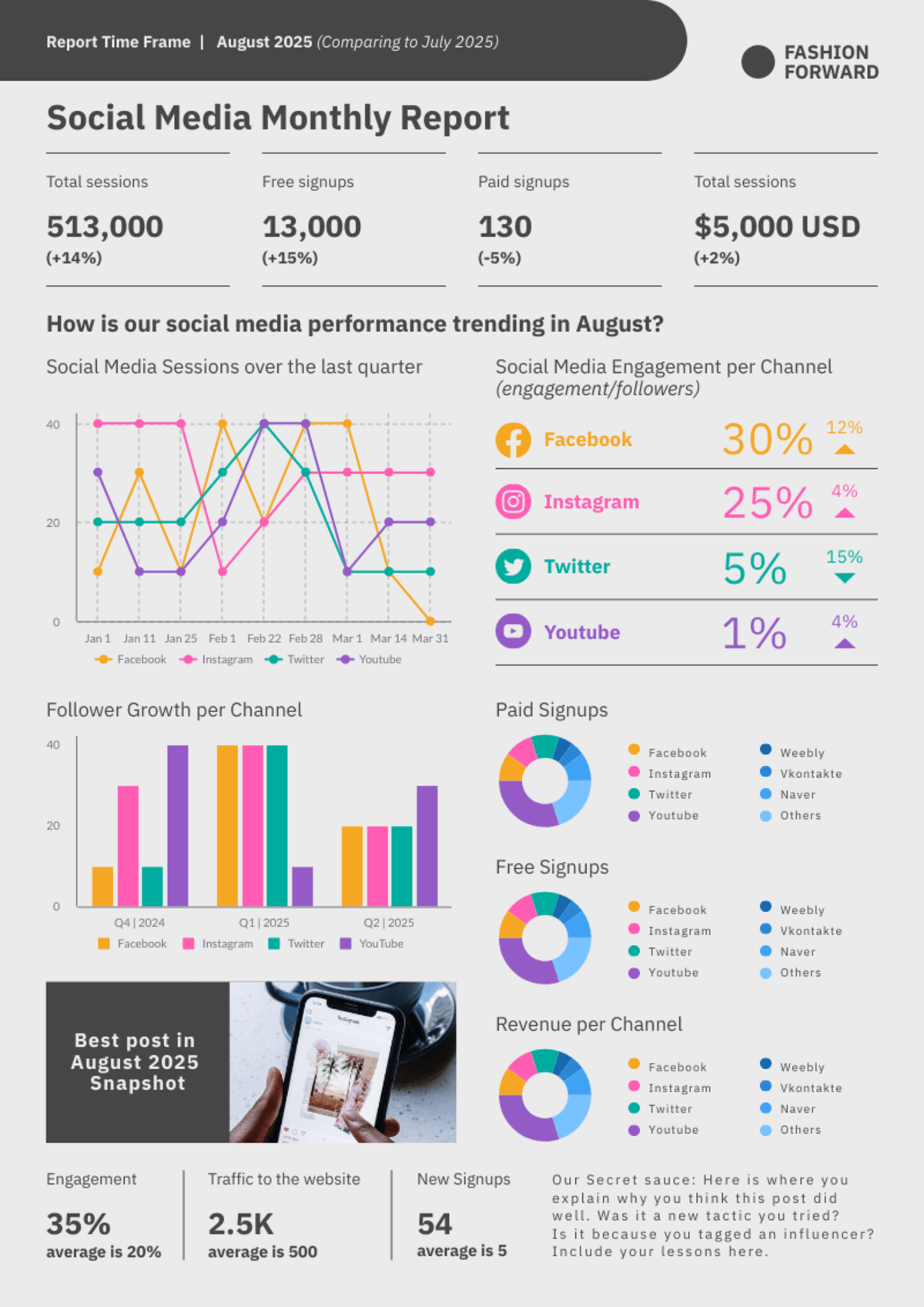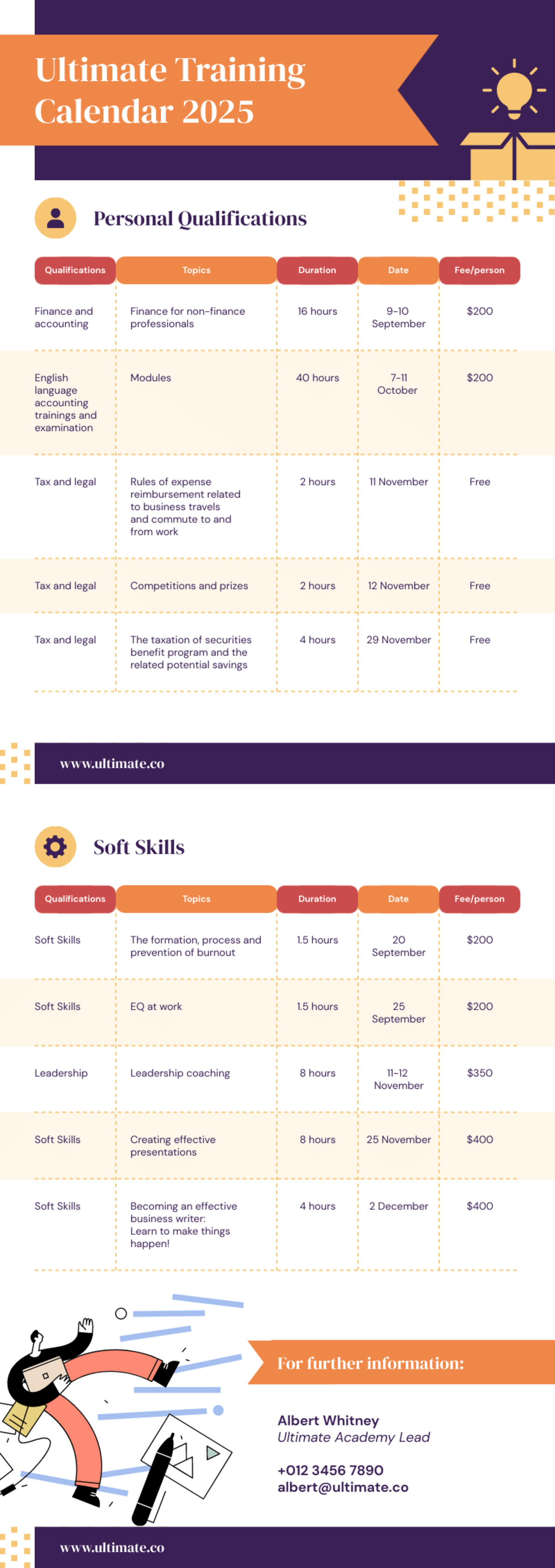
Progress reports are essential for effective project management. Well-crafted progress reports streamline communication and keep stakeholders up to date on a project’s status. Organizing and presenting task details, achievements, challenges, and other factors relevant to a project helps maintain alignment with the project goals and timelines. When multiple teams are working on the same project, progress reports aid in collaboration and accountability.
However, creating these reports can be time-consuming. Fortunately, there are templates and tools you can use to significantly reduce the time spent on report creation while enhancing their effectiveness. In this article, we give you a comprehensive guide to progress report templates, including how to choose the right Piktochart template for your specific needs.
Pro tip: Piktochart offers templates that you can easily customize for different project types. It also has an AI report generator that lets you create progress reports in a fraction of a time – give it a go to create your own report in seconds!
A progress report presents the status of a project. It defines goals, key achievements, challenges, future plans, and other factors unique to the project. Some key elements of an effective progress report are:
Pro Tip: If you’re designing your own progress report, try to tailor its depth and breadth to your audience. Executive stakeholders may prefer high-level summaries, while project team members with different expertise may benefit from detailed updates.
While creating comprehensive progress reports can be time-consuming, using well-designed templates can streamline the process without sacrificing quality or thoroughness. Aside from saving time, templates guide you in creating professional-looking reports that can give your brand a good and credible image.
How do you know which template to use? That’s what we go over in the next section.
The right template is the one that fits your project’s distinct requirements. While there isn’t a single template that fits your needs out of the box, identifying one that closely aligns with your goals can provide a strong foundation for customization.
In choosing a template, consider these factors:
Who will read the progress report? Are they team members, stakeholders, or clients? This will help you decide which aspects of the project to highlight.
Is your audience non-technical? Keep things simple and jargon-free. Look for templates with high-level overviews, visuals, and key takeaways.
On the other hand, a more technical audience would likely want a detailed analysis with more specifics and data. So for this audience type, look for templates with space for more text for technical specifications, as well as flexibility to include relevant charts or technical diagrams.
How often you need to deliver progress updates will determine how extensive the report should be. For weekly report templates, consider doing the following:
If you’re using monthly reports, the level of detail will differ slightly. Some recommended actions would be to:
A quarterly report will warrant an even higher-level view since you’ll be looking at things from a bird’s eye perspective and need less granular detail. We suggest that you:
Pro tip: No matter what frequency of report you’re using, stay consistent with your core metrics so it’s easy to track and compare over time.
What information is most important to your project and audience? For a marketing project, this might be metrics like lead generation, conversion rates, and ROI. For a software development project, it might be sprint velocity, bug count, and feature completion rates. Choose templates that highlight these metrics prominently and allow for easy customization as project priorities evolve.
Does your project follow a specific management methodology like Agile, Waterfall, or Lean? Your progress report template should align with this methodology. For Agile projects, include sprint summaries, burndown charts, and retrospective insights. For Waterfall projects, focus on phase completions, timeline adherence, and risk management.
Note that the best progress report template is one that can be easily adapted to fit your project’s unique needs.

A minimalistic design that shows project updates clearly and concisely. Customize the red-and-white color scheme with your brand colors for a personalized touch.
Best for: Delivering concise, high-impact updates to time-pressed stakeholders.
Key components:
Pro Tip: Maximize impact by limiting your report to 5-7 key data points on a single page. For deeper dives, provide links to more detailed resources.

This project summary template balances professionalism and creativity. Color blocks and insightful icons make status reports fun to read.
Best for: Client-facing reports where putting your brand identity in the spotlight is as important as sharing your project’s progress.
Key components:
Pro Tip: Customize with your brand colors and logo to make your brand identity stand out.

Customize this daily calendar sheet to show your project’s daily and weekly progress.
Best for: Tracking daily progress on projects with quick turnarounds.
Key components:
Pro Tip: For a five-day workweek, use the bottom-right box to summarize progress for the entire week.

Transform large and complex datasets into easy-to-understand visual reports with this comprehensive dashboard-type template.
Best for: Simplifying data-heavy progress reports for social media campaigns, sales reports, and other complex projects.
Key components:
Pro Tip: Tone down colors for a more professional look, but keep them vibrant if you’re in the creative field.

Quarterly reports, such as sales performance reports, are often heavy on data. This template streamlines quarterly data into a digestible format tailored to stakeholders.
Best for: Making data/statistics easier to understand for readers who want to see everything in a single glance.
Key components:
Pro Tip: Implement the ‘Rule of Three‘ in your executive summary – focus on three key achievements or insights that encapsulate your quarter’s story. This approach helps stakeholders quickly grasp the most crucial information.

This versatile report template isn’t just for student assessments but also offers a comprehensive framework for tracking individual progress and performance.
Best for: Reporting employee performance reviews, student progress reports, and long-term personal development tracking.
Key components:
Pro Tip: When adapting this template for employee reviews, include a self-assessment section. This encourages self-reflection and facilitates more meaningful two-way feedback conversations.

Keep your staff up to date with the training schedule so they can mark their own calendars.
Best for: HR departments, Learning & Development teams, and organizations that want to keep employees informed on professional development programs.
Key components:
Pro Tip: Integrate a feedback mechanism into your training report. Include space for post-training evaluation summaries and participant testimonials. This not only tracks training effectiveness but also helps in continually refining your development programs.

Make your training programs more effective by encouraging self-monitoring of progress. This template structures program content to make it easy for participants to understand and achieve their goals.
Best for: Tracking progress during mentoring/coaching programs.
Key components:
Pro Tip: Keep descriptions as concise as possible to avoid overwhelming readers with huge chunks of text.
Make your reports clear, engaging, and useful for everyone by following the best practices.
Collaboration ensures your report is accurate and comprehensive. This collaborative approach not only improves accuracy but also increases buy-in and alignment across teams.
Don’t rely on assumptions or vague information. Always use reliable sources and clarify any uncertainties. Accurate data ensures your report is trustworthy and actionable.
Avoid complicated jargon or overly technical language. You don’t need highfalutin words to sound professional. In fact, you’d get your point across better with simple wording and clear messaging.
Use data to back up your points, but don’t overwhelm your audience with too many numbers. Prioritize data that effectively communicates your message. Provide clear, accurate interpretations of data trends and implications. Contextualize numbers to demonstrate their relevance to overall project objectives.
While essential, progress reports can be time-consuming. Fortunately, the templates on Piktochart cut down the time and effort needed to make them. Simply select a template and input the right information to create effective and visually appealing progress reports. Customize colors, fonts, and images to reflect your brand identity.
To further streamline the report-making process, try out Piktochart’s AI report generator. Once you experience how effortless and efficient creating progress reports can be, you’ll never want to make reports from scratch.